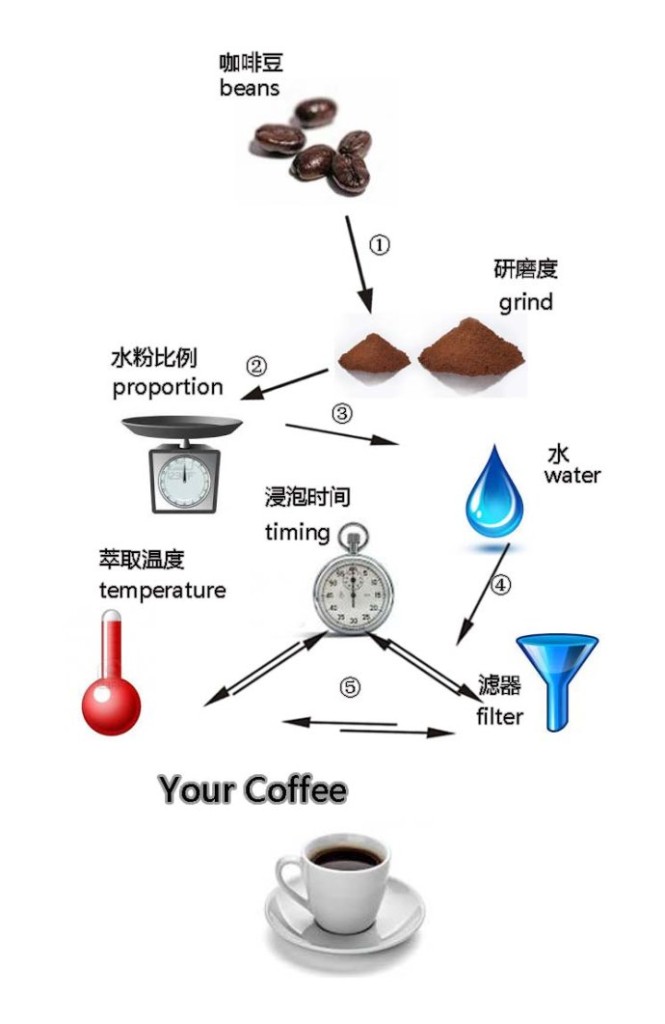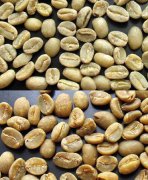Skills of making coffee by hand
Hand brewed coffee consumables: coffee, filter paper, water;
Hand made coffee appliances: consider cup, pot, water injection appliances, weighing appliances, timing tools, thermometers, grinding tools;
There are several factors that affect the production of hand-brewed coffee:
Selection of coffee beans:
We make coffee, not orange juice, not green tea, so the coffee itself determines the basic taste of this cup of coffee. For example, whether the coffee is sun-cured or washed, whether it comes from Indonesia in Asia, Colombia in South America, or Ethiopia in Africa. When coffee is certain, the taste in your cup is actually 50% certain. This was the most crucial link.
Degree of grinding and uniformity of coffee:
The degree of coffee grinding directly determines the amount of coffee substances extracted during the brewing process. In unit time, the coarser the coffee substance, the harder it is to extract, and the faster the extraction speed, the lighter or stronger the taste. Under normal circumstances, our coffee mill can not be absolutely uniform, after you choose a good thickness, there will generally be a certain proportion of powder that does not meet your requirements, which will increase the layering of coffee taste, and excessive unevenness will make coffee taste "out of control".
Water quality and temperature:
Water quality varies across the country, and it is generally believed that water quality in the north is not as good as that in the south. There are two choices of water for coffee, treated water and bottled water. The so-called treated water is tap water treated by a water softener, water purifier or pure water machine. This water can be used to make coffee, and the taste is far better than tap water. Another category is the use of purchased purified water to make coffee. Cost isn't what we're thinking about today, so we can basically default to a more expensive treatment, maybe, we're talking about maybe it's going to taste better.
Water temperature is also an important indicator of coffee taste. When I personally make coffee, I am used to using a water temperature of about 90 degrees, which is of course in line with my grinding thickness. You don't have to be so precise. In fact, you can fix a personal habit, such as standing for 1 minute or 1.5 minutes after the water is completely opened. Of course, you should adjust this time according to the temperature in the room. It is estimated that there will be a temperature difference between winter and summer.
Coffee brewing time:
This is easy to understand. The longer you soak, the more substance you extract and the stronger the taste, and vice versa. However, what factors will affect the soaking time, let's discuss them in detail.
The first is the degree of coffee grinding, coarse water filtration fast, fine water filtration slow, which we can imagine, filter water fast, unit water naturally coffee and water contact time is short, taste will be weak, and vice versa.
Then is the filter, we commonly used a filter is filter paper, a good filter paper should be no odor, good water filtration. I have used a poor quality filter paper, very thin, but the filtering speed is very slow, only see the water injection, but not the downflow, which inevitably leads to a long soaking time. In addition, common filters include flannel and metal. It is generally believed that these materials, filter paper filterability is the best, the disadvantage is high cost, may have the taste of pulp. Flannel is also widely believed to have excellent filtration effect, making coffee taste soft, high alcohol, but repeated use, flannel is easy to absorb the taste of coffee, causing cross-contamination. Finally, metal filters are considered the worst filters and make it difficult to filter out some very fine coffee grounds.
There is also an element that affects the soaking time, which is the method and method of hand flushing water injection. Some friends like to inject water in one breath, that is, uninterrupted water injection, some people like 2 times of water injection, some people like more times of water injection. You can try to count the time separately, you can find that the difference in water injection method can cause a great time difference, that is, the coffee soaking time in water is different. Usually my personal preference for 20 grams of coffee is steeping for about 2 minutes. Of course, if you use an ordinary kettle instead of a dedicated hand rinse pot, it may be difficult for you to control your water volume, and you will not be able to accurately grasp your filling time.
The proportion of water and powder when brewing coffee:
When we make tea, we may all know the most basic truth, if you want to make it thicker, put more tea leaves. The same applies to coffee making. For stronger coffee, we put more coffee powder. However, if we want to make a stable cup of coffee that tastes the same every day, John recommends that we have a standard, or at least a personal, ratio of water to powder. John's personal habit is 20 grams of coffee, water injection 300 ml, that is, powder water ratio of 1:15. Of course, this is also on the premise that I fix the water temperature and grinding thickness. This is a basic universal ratio, which can then be fine-tuned to specific coffee and personal preferences.
Speaking of this, in fact, we should have a little idea, in fact, the key factors of coffee making will interact, they will cycle. For example, coffee grinds are coarsely ground, the water will filter faster, and the taste will be lighter, but you can slightly increase the water temperature or increase the steeping time to adjust the taste of the cup. But no matter how you tweak it, you can't change your coffee beans. This is the theme of your cup of coffee. We'll talk to you about how to choose a coffee that suits you in a later article.

Important Notice :
前街咖啡 FrontStreet Coffee has moved to new addredd:
FrontStreet Coffee Address: 315,Donghua East Road,GuangZhou
Tel:020 38364473
- Prev

Grading of raw coffee beans
There are two ways to classify raw coffee beans, one is the filter number, and the other is the elevation. It is divided by the filter number, and the size is size in terms of the screen size. Round beans are generally smaller than flat beans, between 8-13 and 12-29. 8, 9, 10. 12, 13. 18. 29 = small, medium, ordinary. Quasi-big. Big, extra large. The bigger the size, the bigger the beans. Like SC-.
- Next

The secret of coffee beans
How can we drink good coffee? why do we usually drink coffee so bitter that it doesn't taste like what the experts and teachers say? the main reason is that we don't know the correct way to drink and use the coffee.
Related
- Guji coffee producing area of Guji, Ethiopia: Humbela, Shakiso, Wulaga
- What is the most expensive variety of Qiloso in BOP multi-variety group?
- How to store the coffee beans bought home?
- Why are Yemeni coffee beans so rare now?
- Ethiopian Sidamo all Red Fruit Sun Sun Santa Vini Coffee beans
- SOE is mostly sour? What does it mean? Is it a single bean? what's the difference between it and Italian blending?
- Is Italian coffee beans suitable for making hand-brewed coffee?
- How to choose coffee beans when making cold coffee? What kind of coffee beans are suitable for making cold coffee?
- Just entered the pit to make coffee, what kind of coffee beans should be chosen?
- Can only Japan buy real Blue Mountain Coffee? What are authentic Jamaican Blue Mountain coffee beans?

